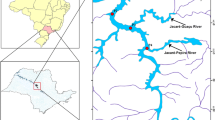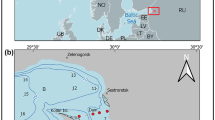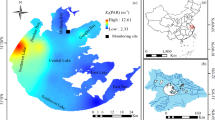Abstract
Sunlight penetration through the water column is controlled by the amount and kind of materials dissolved and suspended in the water. Understanding UV penetration in its complexity is essential for the prediction of the impact of UV radiation on aquatic ecosystems. However, only limited data are available on the penetration of UVR into shallow waters rich in inorganic suspended solids and chromophoric dissolved organic matter (CDOM). The same is true for the specific attenuation coefficients of light-absorbing components at the UV waveband. This study analyses the role of CDOM, algal-free suspended solids and algae in the formation of underwater UVR and PAR climate in 30 water bodies from clear gravel pit lakes trough the shallow Lake Balaton to turbid soda pans. Irradiance-depth profiles were obtained at 305, 313, 320 nm (UV-B), 340, 380, 395 nm (UV-A) and 400–700 nm (PAR) with a Biospherical PUV-2500 radiometer. Vertical attenuation coefficients (K d) were calculated. Water samples were taken for the laboratory measurement of the concentration of light-absorbing components: algae as chlorophyll a (CHL), chromophoric dissolved organic matter as colour (CDOM), and algal-free suspended solids (TSS-Alg) parallel with the in situ light measurements. Specific attenuation coefficient values were calculated by multiple regression analysis (n = 140). The obtained specific UV attenuation coefficient values of CHL, CDOM and TSS-Alg made it possible to establish light attenuation at different wavelengths based on the knowledge of the concentration of these light-absorbing components.







Similar content being viewed by others
References
Arst, H., T. Nõges, P. Nõges & B. Paavel, 2008. Relations of phytoplankton in situ primary production, chlorophyll concentration and underwater irradiance in turbid lakes. Hydrobiologia 599: 169–176.
Arts, M. T., R. D. Robarts, F. Kasai, M. J. Waiser, V. P. Tumber, A. J. Plante, H. Rai & H. J. De Lange, 2000. The attenuation of ultraviolet radiation in high dissolved organic carbon waters of wetlands and lakes on the northern Great Plains. Limnology and Oceanography 45: 292–299.
Bannister, T. T., 1974. A general theory of steady state phytoplankton growth in a nutrient saturated mixed layer. Limnology and Oceanography 19: 13–30.
Belmont, P., B. R. Hargreaves, D. P. Morris & C. E. Williamson, 2007. Estimating attenuation of ultraviolet radiation in streams: field and laboratory methods. Photochemistry and Photobiology 83: 1339–1347.
Bowers, D. G., G. E. L. Harker, P. S. D. Smith & P. Tett, 2000. Optical properties of a region of freshwater influence (The Clyde Sea). Estuarine, Coastal and Shelf Science 50: 717–726.
Cloern, J. E., 1987. Turbidity as a control on phytoplankton biomass and productivity in estuaries. Continental Shelf Research 7: 1367–1381.
Cuthbert, I. D. & P. del Giorgio, 1992. Toward a standard method of measuring color in freshwater. Limnology and Oceanography 37: 1319–1326.
De Lange, H. J., 2000. The attenuation of ultraviolet and visible radiation in Dutch inland waters. Aquatic Ecology 34: 215–226.
Di Toro, D. M., 1978. Optics of turbid estuarine waters: approximations and applications. Water Research 12: 1059–1068.
Dubinsky, Z., 1980. Light utilization efficiency in natural phytoplankton communities. In Falkowski, P. G. (ed.), Primary productivity in the sea. Plenum, New York: 83–89.
Gons, H. J., J. Ebert & J. Kromkamp, 1998. Optical teledetection of the vertical attenuation coefficient for downward quantum irradiance of photosynthetically available radiation in turbid inland waters. Aquatic Ecology 31: 299–311.
Huovinen, P. S., H. Penttilä & M. R. Soimasuo, 2003. Spectral attenuation of solar ultraviolet radiation in humic lakes in Central Finland. Chemosphere 51: 205–214.
Joint, I. R. & A. J. Pomroy, 1981. Primary production in turbid estuary. Estuarine, Coastal and Shelf Science 61: 251–259.
Kerr, J. B. & C. T. McElroy, 1993. Evidence for large upward trends of ultraviolet-B radiation linked to ozone depletion. Science (Washington, DC) 262: 1032–1034.
Kirk, J. T. O., 1994. Optics of UV-B radiation in natural waters. Archiv für Hydrobiologie Beiheft Ergebnisse der Limnologie 43: 1–16.
Kirk, J. T. O., 1996. Light and photosynthesis in aquatic ecosystems. 2nd ed. Cambridge University Press, Cambridge: 509 pp (reprinted).
Laurion, I., M. Ventura, J. Catalan, R. Psenner & R. Sommaruga, 2000. Attenuation of ultraviolet radiation in mountain lakes: factors controlling the among- and within-lake variability. Limnology and Oceanography 45: 1274–1288.
Lund-Hansen, L. C., 2004. Diffuse attenuation coefficients K d (PAR) at the estuarine North Sea–Baltic Sea transition: time-series, partitioning, absorption and scattering. Estuarine, Coastal and Shelf Science 61: 251–259.
Malone, T. C., 1977. Environmental regulation of phytoplankton productivity in the lower Hudson Bay Estuary. Estuarine, Coastal and Shelf Science 5: 157–171.
Markager, S. & W. F. Vincent, 2000. Spectral light attenuation and the absorption of UV and blue light in natural waters. Limnology and Oceanography 45: 642–650.
McMahon, T. G., R. C. T. Raine, T. Fast, L. Kies & J. W. Patching, 1992. Phytoplankton biomass, light attenuation and mixing in the Shannon estuary, Ireland. Journal of the Marine Biological Association of the UK 72: 709–720.
McPherson, B. F. & R. L. Miller, 1987. The vertical attenuation of light in Charlotte Harbor, a shallow, subtropical estuary, south-western Florida. Estuarine, Coastal and Shelf Science 25: 721–737
Morris, D. P., H. Zagarese, C. E. Williamson, E. G. Balseiro, B. R. Hargreaves, B. Modenutti, R. Moeller & C. Queimalinos, 1995. The attenuation of solar UV radiation in lakes and the role of dissolved organic carbon. Limnology and Oceanography 40: 1381–1391.
Pálffy, K. & L. Vörös, 2003. Effect of ultraviolet radiation on phytoplankton primary production in Lake Balaton. Hydrobiologia 506–509: 289–296.
Pennock, J. R., 1985. Chlorophyll distributions in the Delaware Estuary: regulation by light limitation. Estuarine, Coastal and Shelf Science 21: 711–725.
Phlips, E. J., F. J. Aldridge & C. L. Schelske, 1995a. Relationships between light availability, chlorophyll a, and tripton in a large, shallow subtropical lake. Limnology and Oceanography 40: 416–421.
Phlips, E. J., T. C. Lynch & S. Badylak, 1995b. Chlorophyll a, tripton, color, and light availability in a shallow tropical inner-shelf lagoon, Florida Bay, USA. Marine Ecology Progress Series 127: 223–234
Priscu, J. C., 1983. Suspensoid characteristics in subalpine Castle Lake, California. II. Optical properties. Archiv für Hydrobiologie 97: 425–433.
Reynolds, C. S., 1984. The ecology of freshwater phytoplankton. Cambridge University Press, Cambridge: 400 pp.
Scott, B. D., 1978. Phytoplankton distribution and light attenuation in Port Hacking Estuary. Australian Journal of Marine and Freshwater Research 29: 31–44.
Scully, N. M. & D. R. S. Lean, 1994. The attenuation of ultraviolet radiation in temperate lakes. Archiv für Hydrobiologie Beiheft Ergebnisse der Limnologie 43: 135–144.
Smith, W. O., 1982. The relative importance of chlorophyll, dissolved and particulate material and seawater to the vertical extinction of light. Estuarine, Coastal and Shelf Science 15: 459–465.
Smith, R. C. & K. S. Baker, 1978. The bio-optical state of ocean waters and remote sensing. Limnology and Oceanography 23: 247–259.
Smith, R. C. & K. S. Baker, 1979. Penetration of UV-B and biologically effective dose-rates in natural waters. Photochemistry and Photobiology 29: 311–323.
Smith, R. C. & K. S. Baker, 1981. Optical properties of the clearest natural waters (200–800 nm). Applied Optics 20: 177–184.
Sommaruga, R., 2001. The role of solar UV radiation in the ecology of alpine lakes. Journal of Photochemistry and Photobiology 62: 35–42.
Sommaruga, R. & R. Psenner, 1997. Ultraviolet radiation in a high mountain lake of the Austrian Alps: air and underwater measurements. Photochemistry and Photobiology 65: 957–963.
Vant, W. N., 1990. Causes of light attenuation in nine New Zealand estuaries. Estuarine, Coastal and Shelf Science 31: 125–137.
V.-Balogh, K. & L. Vörös, 2001. Wetlands on the watershed of Lake Balaton and their impact on water quality. BIWAKO 2001. 9th International Conference on the Conservation and Management of Lakes. Conference Proceedings. Session 5. 5B-P06: 197–200.
Verduin, J., 1964. Principles of primary productivity: photosynthesis under completely natural conditions. In Jackson, D. F. (ed.), Algae and man. Plenum, New York: 211–238.
Verduin, J., 1982. Components contributing to light extinction in natural waters: method of isolation. Archiv für Hydrobiologie 93: 303–312.
Villafañe, V. E., M. Andrade, V. Lairana, F. Zaratti & W. Helbling, 1999. Inhibition of phytoplankton photosynthesis by solar ultraviolet radiation: studies in lake Titicaca, Bolivia. Freshwater Biology 42: 215–224.
Vincent, W. F., M. Kumagai & C. Belzile, 2001. Effects of seston on ultraviolet attenuation in Lake Biwa. Limnology 2: 179–184
Vörös, L., E. Boros, A. Schmidt, K. V.-Balogh, B. Németh, B. Somogyi & A. Mózes, 2006. Physical and chemical environment of phytoplankton in soda pans having white coloured water. Hidrológiai Közlöny 86: 139–141. (in Hungarian with English summary).
Weidemann, A. D. & T. T. Bannister, 1986. Absorption and scattering coefficients in Irondequoit Bay. Limnology and Oceanography 31: 567–583.
Weidemann, A. D., T. T. Bannister, S. W. Effler & D. L. Johnson, 1985. Particulate and optical properties during CaCO3 precipitation in Otisco Lake. Limnology and Oceanography 30: 1078–1083.
Wetzel, R. G. & G. E. Likens, 1991. Limnological analyses, 2nd ed. Springer, Verlag.
Xu, J., R. R. Hood & S.-Y. Chao, 2005. A simple empirical optical model for simulating light attenuation variability in a partially mixed estuary. Estuaries and Coasts 28: 572–580.
Zhang, Y., B. Zhang, R. Ma, S. Feng & C. Le, 2007. Optically active substances and their contributions to the underwater light climate in Lake Taihu, a large shallow lake in China. Fundamental and Applied Limnology 170: 11–19.
Acknowledgements
This work has been financially supported by grant No. K 63296 of the Hungarian Scientific Research Fund (OTKA). We wish to thank Kati Vörös for revising the English text and Zoltán Botta-Dukát for his invaluable statistical advices.
Author information
Authors and Affiliations
Corresponding author
Additional information
Rights and permissions
About this article
Cite this article
V.-Balogh, K., Németh, B. & Vörös, L. Specific attenuation coefficients of optically active substances and their contribution to the underwater ultraviolet and visible light climate in shallow lakes and ponds. Hydrobiologia 632, 91–105 (2009). https://doi.org/10.1007/s10750-009-9830-9
Received:
Revised:
Accepted:
Published:
Issue Date:
DOI: https://doi.org/10.1007/s10750-009-9830-9




